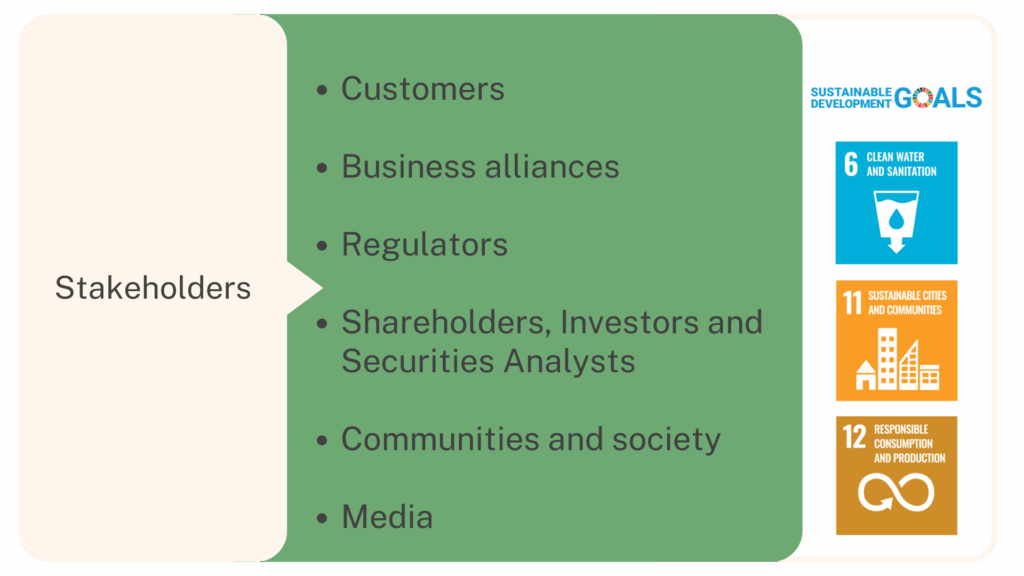
Importance
Airport management, infrastructure development, and expansion must be conducted with a structured approach to managing the impacts arising from business operations. This is essential for controlling both positive and negative impacts on various stakeholders—particularly regulatory agencies, shareholders, investors, and securities analysts—who have a high level of interest and expectations regarding AOT’s management practices and environmental impacts.
AOT places great importance on environmental matters, which can be categorized into key issues such as noise management, air quality, water and wastewater management, waste management, and biodiversity. These environmental issues can have wide-ranging impacts in various forms. AOT recognizes and acknowledges the importance of addressing these potential challenges through established environmental management measures and plans, ensuring operations are aligned with environmental sustainability. This approach not only enhances value creation but also responds to stakeholder expectations and aligns with both domestic and international corporate sustainability assessment criteria.
Policy
Airport Environmental Management Policy
Airport Environmental Management Policy coverage operations of AOT head office and six airports, suppliers, and partners. AOT is committed to managing its airports in accordance with best practices in environmental management (Environmental Management System: EMS), with the aim of becoming a leading international eco-airport under the vision “Moving toward International Leading Eco-Airport.”, committing to continuous improvement of environmental performance which covers the company’s operations, suppliers, and business partners throughout value chain. This also includes consulting external stakeholders in the development and implementation of the environmental policy.
To translate this commitment into concrete action, in 2024, AOT established the AOT Subcommittee on Sustainable Development to drive forward environmental management policies and action plans, as well as to closely monitor the performance of working groups across all departments to ensure alignment with the environmental management policies and improve environmental performance.
Environmental management at AOT’s six airports is aligned with the AOT Corporate Plan for Fiscal Year 2023–2027 (Revised Edition for Fiscal Year 2024), under Strategic Objective 6: Toward a Socially and Environmentally Friendly Airport, and Strategy 6.1: Advancing Environmental Sustainability and Environmental Policy. This ensures consistency in environmental management practices, mitigation of environmental impacts resulting from business operations, and strict compliance with relevant environmental laws, regulations, and standards.
Furthermore, AOT actively promotes environmental awareness among its personnel to enhance the overall effectiveness and comprehensiveness of environmental management policy and environmental impacts throughout the organization, including both internal and external stakeholders. This also includes consistency training for employees to understand the impact of the company on the environment.
AOT Green ICT Management Policy
AOT’s information technology management is aligned with the AOT Corporate Plan for Fiscal Years 2023–2027 (Revised for Fiscal Year 2024), under Strategic Objective 7: Enhancing Organizational Management Capability, and Strategy 7.2: Improving Work Processes to Enhance Efficiency and Advance Digital Transformation.
This strategic direction encompasses the efficient use of resources and the selection of environmentally friendly technologies through the integration of sound environmental practices across all AOT operations. These efforts are governed by the AOT Green ICT Management Policy and implemented in accordance with the Green ICT Management Guideline, with the aim of promoting the use of eco-friendly information and communication technologies (ICT), minimizing environmental impacts, and improving energy efficiency throughout AOT’s operations.
The framework comprises four key components as follows:
| ICT for Sustainability Category | Description |
|---|---|
| Equipment Lifecycle | Covers all stages from procurement, usage, and maintenance to sustainable disposal. |
| End User Computing |
|
| Enterprise Computing | Server usage is being transitioned to virtualization and cloud computing in order to optimize space utilization and reduce energy consumption. |
| ICT as a Low-Carbon Enabler | Develop a digital ecosystem to support the delivery of digital services, while contributing to climate change mitigation and energy conservation. |
| Procurement | Procure high-efficiency, low-energy ICT equipment that supports reusability and recycling. |
| Recycle & Reuse | Recycle or reuse old equipment to reduce waste. |
| Disposal | Properly dispose of expired equipment in accordance with environmental standards. |
| ICT Environmental Management | Effectively manage the ICT environment through regular equipment maintenance and cleaning. |
AOT promotes sustainability alongside enhancing operational efficiency in the field of technology through the following approaches:
- Encouraging innovation and the development of methods to reduce energy consumption while enhancing the efficiency of service delivery.
- Focusing on the use of reusable resources and minimizing pollution from electronic waste.
- Promoting compliance with AOT’s Green ICT Management Policy among personnel at all levels.
Environmental Sanitation Requirements in Airports
To ensure effective environmental sanitation practices within airports, AOT has established specific criteria and guidelines for environmental sanitation management. These requirements are designed to ensure operational orderliness and compliance with relevant laws and regulations, including those concerning public health, communicable diseases, and environmental protection, as well as applicable international standards.
The requirements cover the management of solid waste, sewage, and contaminants, applying to both AOT personnel and AOT’s business partners. The objective is to implement a systematic waste management approach that prevents undesirable outcomes—such as the presence of disease-carrying insects and animals—within airport premises. Regular inspections are also conducted to ensure that all airport activities are in alignment with these sanitation requirements.
Management Approach
Approach, Organizational Structure, and Responsible Units for Environmental Management
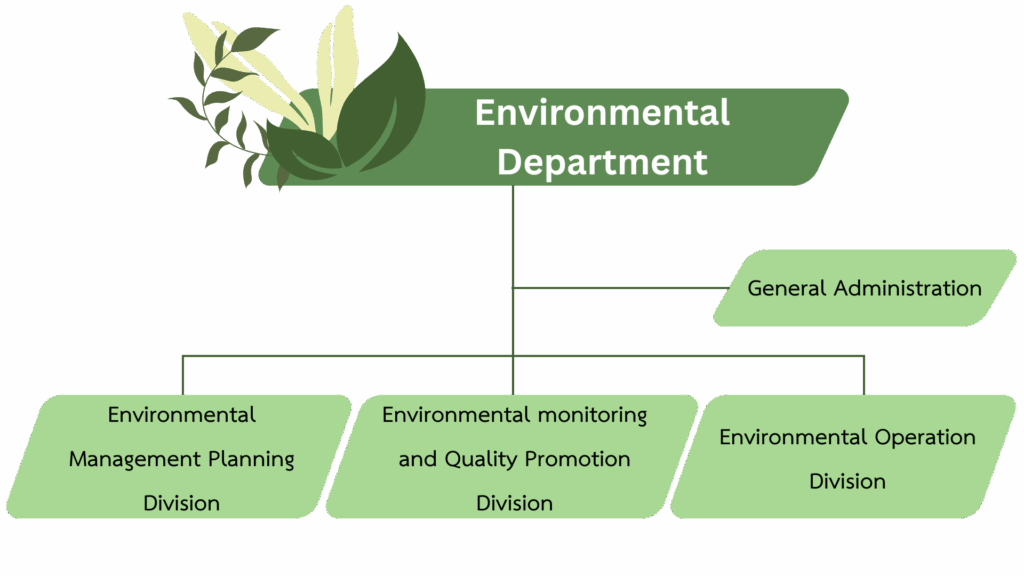
AOT has designated the Environmental Department as the primary unit responsible for managing natural resources and environmental initiatives. The department is tasked with developing environmental policies, plans, and projects to ensure sustainable airport operations. Its structure is divided into four main functional areas: (1) General Administration, (2) Environmental Management Planning, (3) Environmental Quality Monitoring, Inspection, and Promotion, and (4) Environmental Operations. This organizational framework enables AOT to implement systematic and effective environmental management across all its airport facilities.
Implementation of Environmental Law
AOT is committed to conducting its business in full compliance with environmental laws, regulations, and standards, with an emphasis on transparency, accountability, and stakeholder engagement. The company has established formal processes for collecting environmental and social feedback from communities surrounding its airports, and has set up environmental monitoring committees comprising government agencies and community representatives to promote collaboration and ensure diverse viewpoints are considered.
AOT conducts thorough assessments to identify and mitigate potential environmental impacts at every operational stage through Environmental Impact Assessments (EIA) and Environmental Health Impact Assessments (EHIA).
For airports that have undergone these assessments, AOT prepares annual monitoring reports in compliance with legal requirements, detailing the implementation of environmental mitigation and monitoring measures, including environmental quality assessments and community surveys. These reports are submitted annually to the Office of Natural Resources and Environmental Policy and Planning (ONEP).
Critical Environmental Management Practices in Airport Operations
Airport operations have a direct and significant impact on the environment. Recognizing this, AOT places high importance on effective environmental management within its airports. The company defines the scope of key environmental issues through its Environmental Management Policy, along with other relevant policies and regulations, to ensure full legal compliance. AOT implements a wide range of practices aimed at protecting natural resources, reducing pollution, and promoting ecological balance. The overarching goal is to achieve progress and development that harmonize a healthy environment with the well-being of society. Currently, AOT’s environmental management efforts are carried out under five key strategic areas as outlined below:
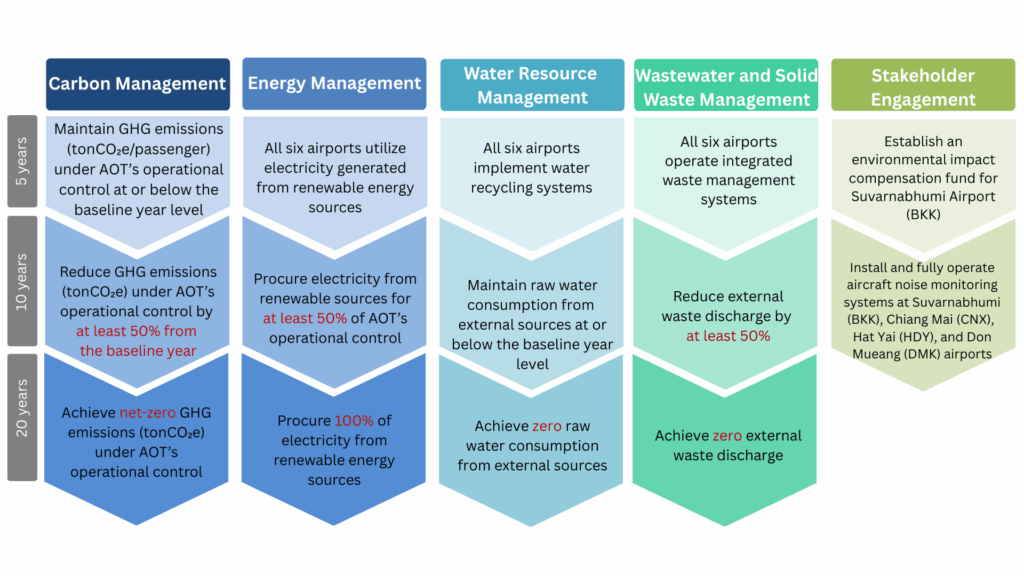
Noise Management
AOT has adopted the Noise Balanced Approach recommended by the International Civil Aviation Organization (ICAO) for managing aircraft noise pollution in a balanced and effective manner. This approach is implemented at AOT-operated airports and consists of four key elements:
- Reduction of Noise at Source:
AOT encourages airlines to use aircraft equipped with engines and designs that emit lower noise levels. Airlines are also advised to manage aircraft weight appropriately to support noise reduction at the source. - Land-use Planning and Management:
AOT provides relevant data—including airport development plans and noise impact zones—to land-use planning authorities to support informed decisions regarding appropriate land utilization around airport areas. - Noise Abatement Operational Procedures:
Airlines operating at AOT airports are required to comply with flight operation procedures—particularly take-off and landing—that minimize noise pollution. These procedures must maintain aviation safety and consider other key factors such as airport capacity, preferential runway use, air traffic management efficiency, and airport accessibility. - Operating Restrictions:
Restrictions are placed on high-noise aircraft. At Suvarnabhumi, Don Mueang, and Chiang Mai International Airports, aircraft must comply with the noise limits outlined in Chapter 3 of Annex 16 of the Convention on International Civil Aviation (Chicago Convention). These requirements are published in the Aeronautical Information Circular (AIC) and must be observed by all airlines.
In addition, to monitor and mitigate noise impacts, AOT conducts noise level measurements using both permanent automatic monitoring stations—operating 24 hours a day—and temporary stations, which conduct biannual measurements over continuous 7-day periods.
Air Quality Management
AOT has continuously implemented measures to prevent and mitigate air quality impacts, covering both ground-based and aircraft-related emission sources, as well as actions specifically targeting the reduction of PM2.5 pollutants. Key air pollution control and prevention measures adopted by AOT include:
- Requiring aircraft to shut down engines and limit the use of Auxiliary Power Units (APUs) while parked at gates or connected to Passenger Loading Bridges, instead utilizing airport-provided electrical power and pre-conditioned air systems through the airport’s utility infrastructure.
- Regulating traffic flow within airport premises, particularly around terminal buildings and parking areas, to prevent congestion and reduce vehicle emissions.
- Mandating regular inspections of vehicles and Ground Support Equipment (GSE) to ensure proper maintenance and compliance with legal emission standards.
- Promoting the use of environmentally friendly vehicles, such as electric-powered vehicles, and encouraging airport staff and passengers to utilize public transportation more frequently to reduce fuel consumption and vehicular emissions.
- Conducting public awareness campaigns to discourage forest and agricultural burning in areas surrounding airports where such activities contribute to local air quality issues.
AOT has implemented an Air Quality Monitoring system to track, inspect, and monitor ambient air quality both within and around its airport premises. The monitoring system includes the following activities:
Temporary ambient air quality monitoring stations are installed at Suvarnabhumi Airport, Don Mueang International Airport, Phuket International Airport, Chiang Mai International Airport, and Mae Fah Luang–Chiang Rai International Airport. These stations operate twice a year, conducting continuous 7-day monitoring sessions. The monitored indicators include:
- Nitrogen Oxide (NOx)
- Carbon Monoxide (CO)
- Total Hydrocarbons (THC)
- Total Suspended Particles (TSP)
- Particulate Matter (PM10)
- Volatile Organic Compounds (VOCs)
- Wind Direction and Wind Speed
Monitoring results indicate that the air quality remains within the legal standard limits, ensuring public health protection by monitoring airborne pollutants that may pose risks to human health.
Suvarnabhumi Airport has installed two permanent ambient air quality monitoring stations to provide continuous surveillance of air quality conditions.
Don Mueang International Airport is preparing to install two permanent ambient air quality monitoring stations during the construction phase of its Phase 3 development project.
Water and Wastewater Management & Programs
AOT places strong emphasis on the efficient management of water and wastewater to ensure sufficient supply for operational needs while preventing and mitigating potential impacts on surrounding ecosystems and communities, both in terms of quantity and quality.
- Water Usage Control
All six airports under AOT’s responsibility, along with the head office, have implemented water conservation awareness campaigns targeting both travelers and employees. In addition, all AOT projects are aligned with Environmental Impact Assessment (EIA) guidelines, which include thorough analysis and assessment of water use efficiency (Water Use Assessment to Identify Opportunities for Water Efficiency Improvements). These assessments consider factors such as surface water quality, hydrology, and drainage to surrounding communities, both during the construction and operational phases. The process is conducted in accordance with scientific principles and through active engagement with local communities and stakeholders across all sectors. - Application of Water Recycling
Airports under AOT’s responsibility are equipped with centralized wastewater treatment systems capable of handling daily wastewater volumes efficiently. These systems are regularly monitored and maintained to ensure effective operation and compliance with legal discharge standards. At Suvarnabhumi, Don Mueang, and Phuket International Airports, additional treatment is applied after centralized wastewater processing to allow for efficient water recycling and reuse. - Water Quality Control
AOT primarily sources its water (water withdrawal) from the Metropolitan Waterworks Authority, Provincial Waterworks Authority, and airport-based water treatment systems, which utilize raw water from groundwater and surface water sources. Each airport has its own water quality control process to ensure that water produced on-site meets the standards for domestic use and consumption as defined by the World Health Organization (WHO). Additionally, tap water quality inside passenger terminal buildings is tested monthly in accordance with the standards set by the Ministry of Public Health.
At Suvarnabhumi Airport, AOT’s main hub, water management operations are conducted by a certified operator accredited under ISO 14001:2015 for environmental management systems. This includes management of water supply, drainage, wastewater collection, and wastewater treatment systems.
Targets and Key Performance Indicators
AOT has established performance indicators to increase the volume of recycled water usage (application of water recycling), setting a target to increase recycled water usage by 20% from the 2024 baseline by the year 2028. This target is outlined in AOT’s Sustainable Development Master Plan for Fiscal Years 2024–2028 (Revised Edition for FY2024).
Waste Management
Waste has become a growing environmental concern due to limited landfill space, greenhouse gas emissions from waste decomposition, and contamination of ecosystems—particularly from plastic waste. AOT recognizes these challenges and has consistently implemented waste management measures across its airports. AOT conducts waste generation assessments across all six airports to determine the amount of waste produced. The characteristics of waste generation vary based on different airport activities, such as construction and operations. The waste from operational activities is influenced by the number of passengers and flights using AOT’s airports for travel. The waste generation from construction activity is conducted the waste identification through EHIA monitoring report to identify opportunities for improving waste performance of AOT.
- Airport Waste Management Practices
AOT collects municipal solid waste by providing appropriately placed and sanitary waste containers throughout airport premises, along with designated waste holding areas. All waste is then transferred to authorized waste disposal service providers. Airports under AOT’s responsibility require daily waste collection to ensure no waste is left on-site. Waste collectors must ensure cleanliness in all collection zones after each round of service and maintain clean conditions along transport routes to prevent spills, debris, or leakage on airport roadways.
Hazardous waste is handled, transported, treated, or disposed of exclusively by legally licensed private operators in accordance with environmental laws and regulations.
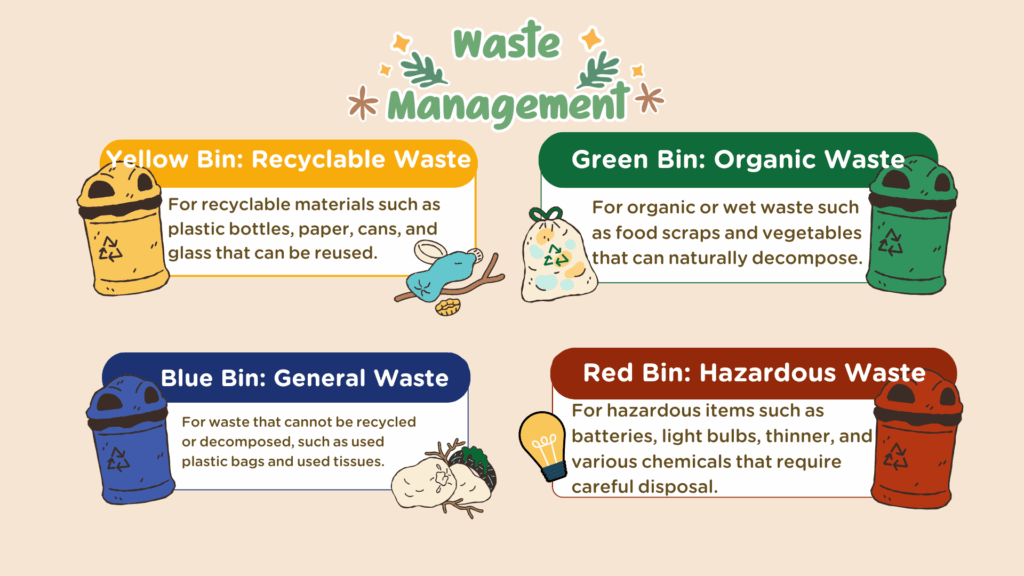
- Types of Waste Classified by Source
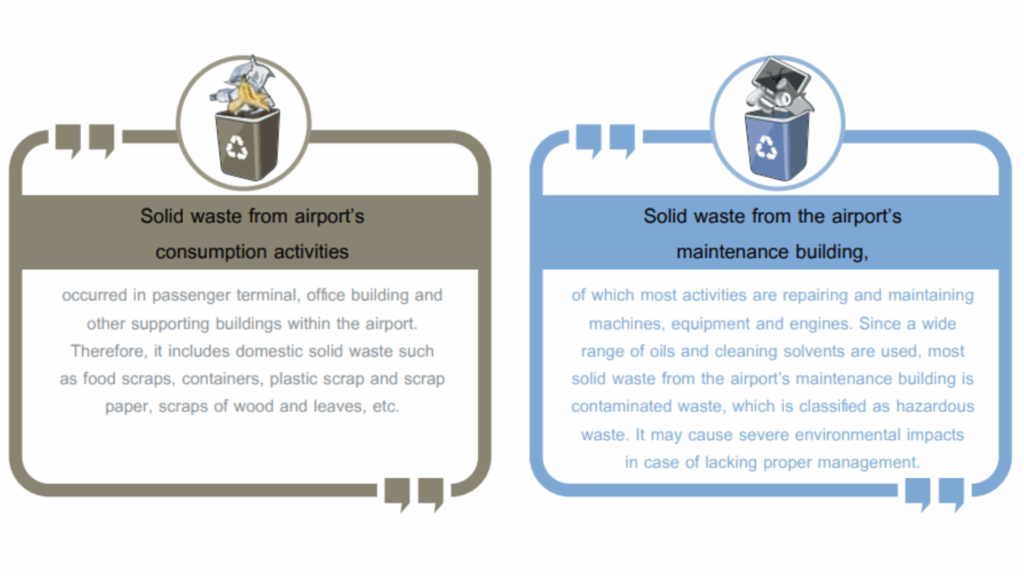
- Types of Waste and Disposal Methods at Airports
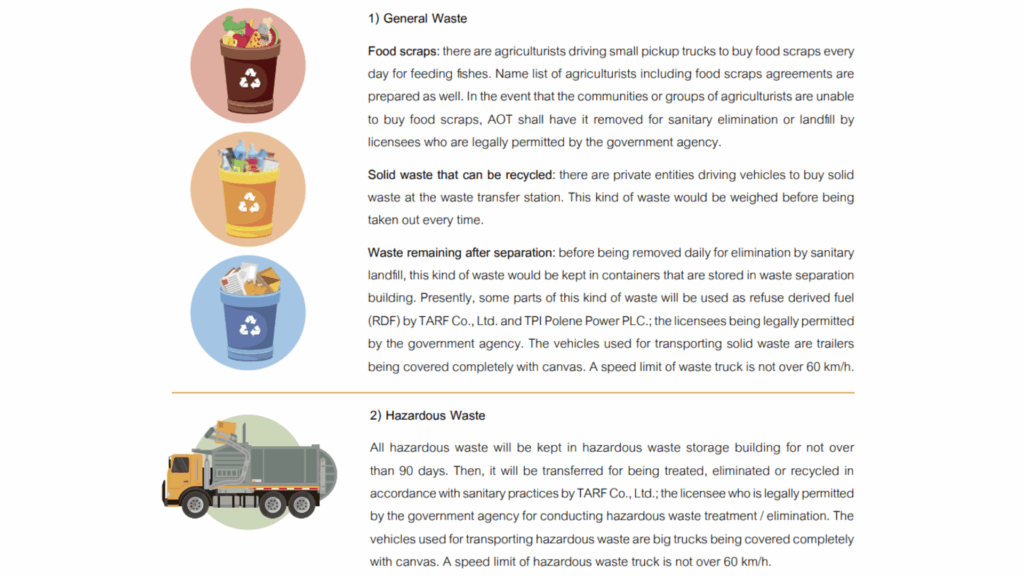
- Waste Disposal
Airports are high-traffic areas where large numbers of passengers generate substantial waste through consumption activities, and also serve as collection points for waste arriving with aircraft. In response, AOT has implemented a comprehensive waste management system, beginning with campaigns to raise awareness among passengers and staff to reduce waste generation. Waste segregation is encouraged within passenger terminals and office buildings, where separate containers are provided for general waste and recyclable waste. Hazardous and infectious waste is collected separately to prevent contamination and is disposed of in accordance with legal and public health standards.
Designated sanitary waste holding areas are arranged according to waste types, such as general and recyclable waste. Local authorities or licensed private contractors are responsible for transporting the waste for disposal, and are required to maintain cleanliness of the storage areas and the waste transport routes after each collection.
In addition, airport operations generate hazardous waste from equipment maintenance—such as oil, solvents, and fluorescent lamps—as well as infectious waste from on-site medical clinics. These types of waste are disposed of by government-authorized service providers in full compliance with relevant environmental and health regulations.
- R&D To Minimize Waste
AOT implements innovation-focused programs to encourage the ideation, design, and development of creative solutions by both internal personnel and external stakeholders. These initiatives serve as a mechanism for identifying and advancing innovative approaches to waste reduction in airport management. Key programs include “Think Out Loud” and the Involution Innovation Contest, which represent AOT’s investment in innovation and R&D aimed at minimizing waste.
These efforts align with AOT’s Sustainable Development Master Plan for Fiscal Years 2024–2028 (Revised Edition for FY2024), which includes performance indicators for the reuse of waste materials under the circular economy model. The target is to develop three recycled or upcycled products by the year 2028 as a measurable outcome of these initiatives.
Resource Efficiency and Circularity
AOT has established a Green ICT Management Policy to actively promote the principles of the circular economy. The policy prioritizes the procurement of electronic equipment with extended lifespans that can be reused or easily recycled, with the aim of minimizing waste generation at the source. This approach also encourages a shift in employee workflows from resource-intensive analog systems to digital platforms that help reduce waste, such as the
e-Document system.
Furthermore, AOT supports the adoption of high-efficiency ICT infrastructure to reduce energy consumption, including the use of Virtualization Servers and Cloud Computing. To reinforce these initiatives, AOT has also developed a Green ICT Management Guideline to guide employees in implementing environmentally friendly ICT practices in a concrete and consistent manner.
This guideline is structured around four key components:
- Equipment Lifecycle
- End User Computing
- Enterprise Computing
- ICT as a Low-Carbon Enabler
Eco-Efficiency Assessment Report
AOT has developed an Eco-Efficiency Assessment Report to evaluate the key environmental impacts associated with airport business operations and to seek room for efficiency improvement. This includes an analysis of resource use throughout the organization’s value chain, encompassing services provided to passengers and airlines across both airside and landside areas to identify opportunities for improving energy water and waste performance and introduce innovations where applicable.
The value chain reflects critical service delivery processes, which are categorized into Core Processes and Supporting Processes that facilitate the execution of core activities. Each process utilizes natural resources in varying degrees, resulting in different levels of environmental impact.
AOT has defined two levels of resource significance:
- Significant: Resources are critical; without them, system operations cannot proceed.
- Insignificant: Operations can continue, but with a reduced level of service.
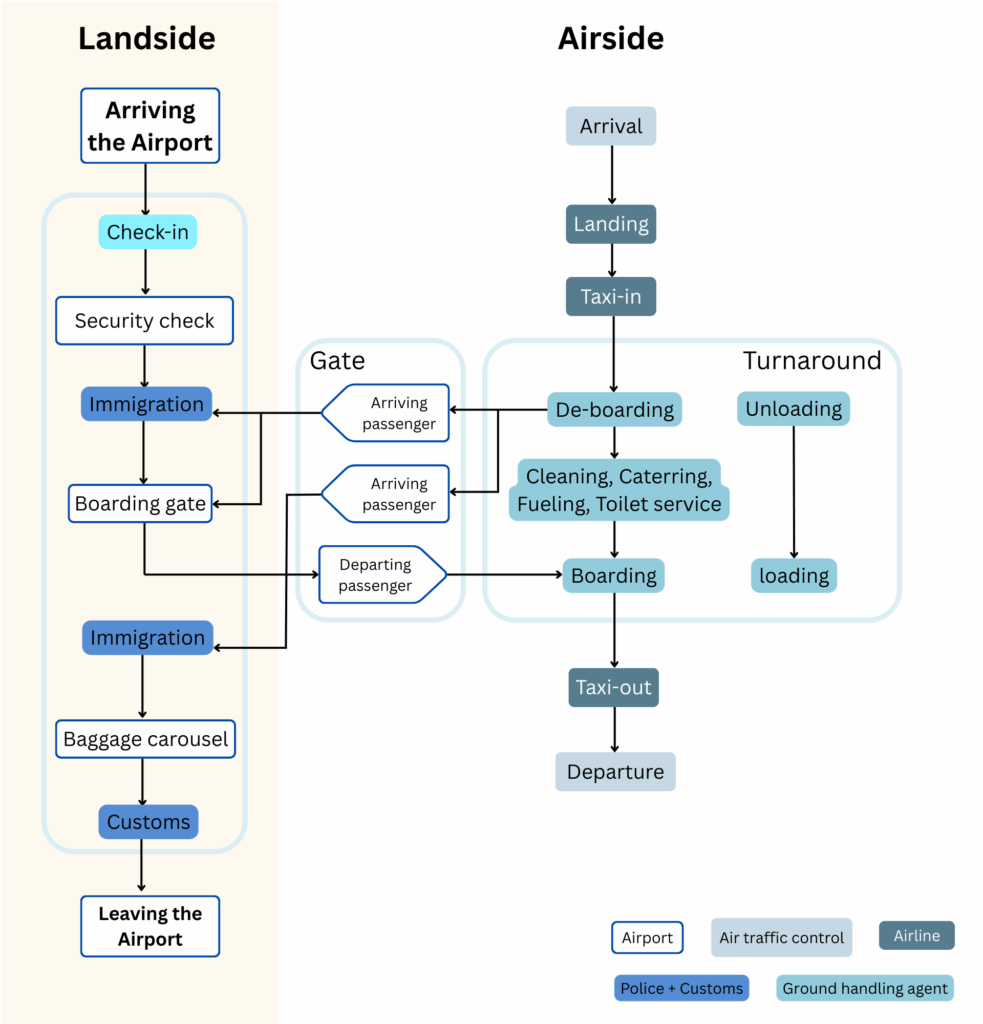
| Environmental Aspect | Core Processes | Supporting Processes | ||||||||||
|---|---|---|---|---|---|---|---|---|---|---|---|---|
| Passenger Arrival | Aircraft Preparation | Baggage Handling | Cargo Handling | Passenger Departure | Planning & Scheduling |
HR | Commercial | Financial | Management | Procurement | IT | |
| Resource Use | ||||||||||||
| - Electricity (kWh) | ✓ | ✓ | ✓ | ✓ | ✓ | ✓ | ✓ | ✓ | ✓ | ✓ | ✓ | ✓ |
| - Water (m³) | ✓ | ✗ | - | ✗ | ✓ | ✗ | ✗ | ✗ | ✗ | ✗ | ✗ | ✗ |
| Environmental Impact | ||||||||||||
| - Greenhouse Gas Emissions (tCO₂) | ✓ | ✓ | ✓ | ✓ | ✓ | ✓ | ✓ | ✓ | ✓ | ✓ | ✓ | ✓ |
| - Solid Waste (kg) | ✓ | ✗ | - | ✗ | ✓ | ✗ | ✗ | ✗ | ✗ | ✗ | ✗ | ✗ |
| - Wastewater (m³) | ✓ | ✓ | - | ✗ | ✓ | ✗ | ✗ | ✗ | ✗ | ✗ | ✗ | ✗ |
✓ Significantly related – operations of each system cannot proceed without it.
✗ Insignificantly related – operations can proceed, but service level may be reduced.
The assessment covers key environmental aspects including electricity (energy), water, greenhouse gas emissions, and solid waste (including both non-hazardous and hazardous waste). The findings of this study will be integrated into the organization’s strategies for improving resource efficiency and promoting conservation.
Biodiversity
AOT is committed to managing and operating airports by adhering to the best practices on airport environmental management and to becoming an international airport that is sustainable and friendly to the environment and the community. AOT recognizes the importance of biodiversity and seeks to promote biodiversity awareness and actions across the value chain, including suppliers and customers. Besides, this has been included an avoidance of operation activities near sites containing globally or nationally important biodiversity of the value chain. While regarding no deforestation as an integral part in biodiversity conservation, AOT intends to compensate and preserve the protected area through the reforestation program towards no net loss annually and aims to limit the impact on biodiversity and deforestation in compliance with our Airport Environmental Management Policy and applicable regulations. This includes but not limited to the following activities;
- Conducting biodiversity impact and risk assessment, mitigation, and monitoring measures according to Environmental Impact Assessment (EIA) and Environmental Impact and Health Impact Assessment (EHIA) Reports.
- Monitoring environmental quality, both terrestrial and aquatic ecosystems, and developing a system for data collection, reporting, and verification to enhance transparency and disclosure of the airport environmental system.
- Limiting biodiversity impact that may be caused by airport waste and wastewater by implementing circular economy principles, enhancing resource utilization efficiency, minimizing waste and effluents that may cause negative impacts on the ecosystem.
- Engaging with employees and all stakeholders in our value chain and other business partners to enhance the value of services while reducing the impact on biodiversity and the ecosystem as a whole.
- Adopting the application of a mitigation hierarchy, i.e., avoid, minimize, restore, and offset, as an approach to initiate biodiversity management.
To prevent wildlife hazards within airport areas, AOT has established the following preventive measures:
- Environmental assessments and habitat management to reduce attractants such as drainage ditches, ponds, grass fields, soil conditions, fencing gaps, bird perching areas, and waste collection zones.
- 24-hour surveillance and active wildlife control, along with real-time wildlife hazard alerts.
- Risk assessment and zoning based on activities within a 13-kilometer radius of the airport (e.g., fish ponds, agriculture) that may pose a wildlife hazard.
- Implements continuous bird hazard management measures to prevent harm to wildlife. These include habitat and attractant management (e.g., removal of food sources and roosting areas), and the use of appropriate bird deterrent methods to prevent birds from becoming accustomed to airport areas. Deterrence techniques, such as sound devices and predator decoys—are developed in-house and operated by AOT staff with expertise in ornithology. AOT also engages external consultants to conduct research and assess the effectiveness of its bird and wildlife strike prevention programs.
- Regular review and updates of wildlife hazard prevention measures to ensure alignment with local ecosystems and current best practices.
- Incident response and reporting procedures in the event of a wildlife-aircraft collision.
The commitment is oversight and endorsed by the Board of Directors.
AOT has consistently carried out reforestation and mangrove restoration activities on an annual basis. These initiatives contribute significantly to biodiversity conservation by providing comprehensive ecological benefits for various species. Mangrove forests serve as nurseries for juvenile aquatic animals, habitats for bird species, and food sources for both terrestrial and aquatic wildlife. They also play a vital role in mitigating the impact of natural disasters on ecosystems and capturing carbon through mangrove vegetation. These efforts support the restoration and regeneration of biodiversity for the benefit of both nature and society, while also generating indirect socio-economic benefits—such as increased income opportunities for local communities living near mangrove forests.
Recognizing the importance of driving effective biodiversity-positive transformation, AOT actively promotes and initiates programs that enhance biodiversity both directly and indirectly. This includes policy-level engagement with trade associations that support climate-related activities, the transition to renewable energy to reduce greenhouse gas emissions, and the development of Sustainable Aviation Fuel (SAF) solutions for airlines as part of a broader strategy to reduce carbon intensity in the aviation industry.
Environmental Complaint Channels
AOT has established channels for receiving environmental complaints, covering issues such as noise and other environmental impacts. These channels are designed to support sustainable, collaborative problem-solving efforts.
A Coordination Center for Environmental Impact Resolution has been established at Suvarnabhumi Airport, with two main areas of responsibility as follows:
Community Relations ActivitiesConducting on-site visits to engage with local residents, clarify AOT’s operations and related impact mitigation measures, and monitor the situation within surrounding communities. The purpose is to gather public feedback, concerns, and complaints for reporting back to AOT to support responsive and inclusive environmental management. |
Telephone Complaint Channel (Call Center)Handles complaints and inquiries related to the compensation procedures for noise impacts caused by Suvarnabhumi Airport operations. The Call Center provides information on relevant plans, procedures, and progress regarding mitigation efforts. In cases where more in-depth information is requested, the Coordination Center will liaise with the appropriate departments to clarify and ensure the inquirer receives accurate and comprehensive explanations. |
Performance
Awareness Environmental Trainings, Meetings, and Seminars
In Fiscal Year 2024, AOT organized and participated in various environmental lectures, meetings, and seminars aimed at enhancing its comprehensive environmental management capacity. These activities were designed to address a wide range of environmental topics and to ensure preparedness for adapting to global trends through the integration of international best practices into AOT’s airport operations.
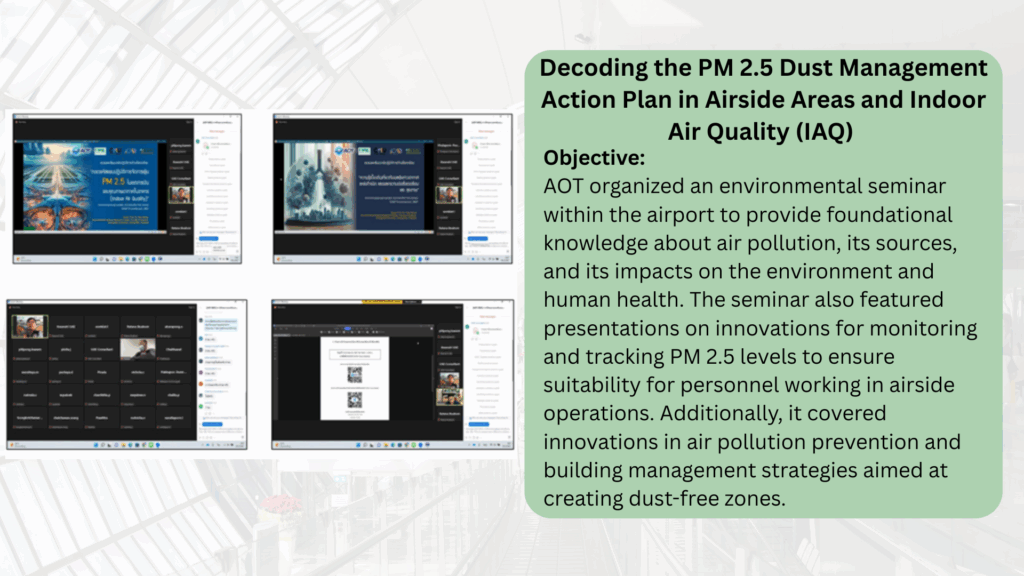
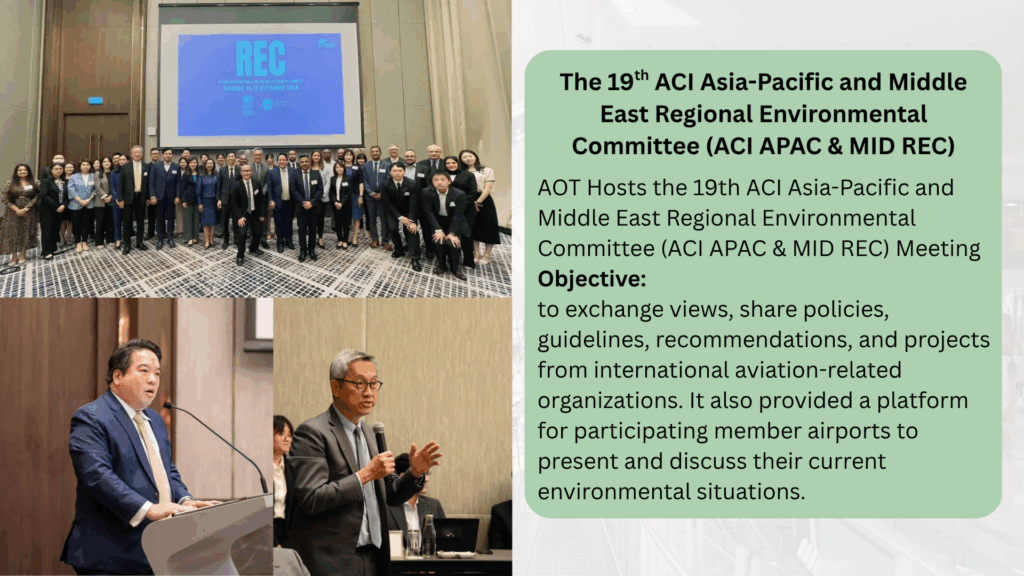
Example of Potable Water Management and Wastewater Treatment Systems
AOT manages water supply and wastewater treatment within its airport operations by installing raw water storage systems for usage purposes and wastewater treatment systems to ensure that all discharged water meets legal and environmental standards. An example is illustrated below:
- Wastewater Treatment System at Phuket International Airport
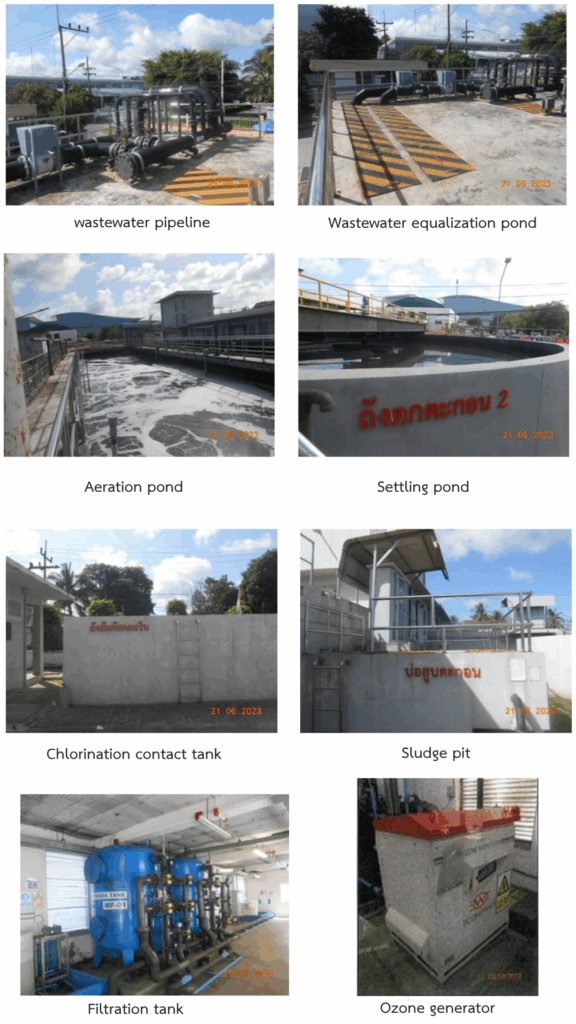
Phuket International Airport Raw Water Storage System
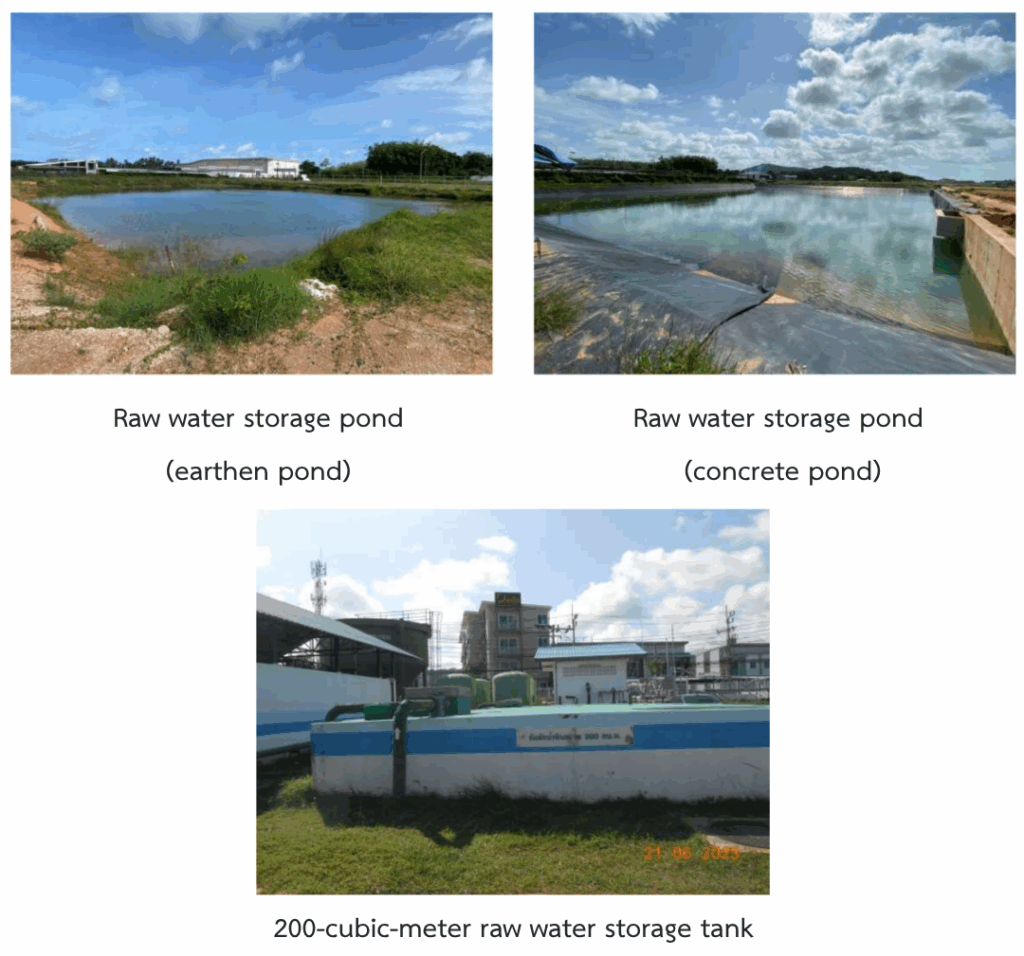
Long-term goals for monitoring environmental performance in airport management
| Environmental Topic | Long-Term Objective |
|---|---|
| Noise Pollution Management | Noise levels comply with legal requirements |
| Air Quality Monitoring | Ambient air quality around the airport complies with legal requirements |
| General and Hazardous Waste Management | Waste reduction volume complies with legal requirements |
|
Water Discharge Quality Management from Treatment System (The Management of Water Discharge Quality from Treatment System) |
Wastewater reduction volume complies with legal requirements |
